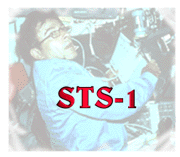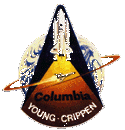
|

|
This page last updated |

|

|
This page last updated |

|
STS-1
OV-102 (Columbia)
|
| 1 | 2 | 3 | 4 | 5 | 6 | 7 | 8 | 9 | 10 | 11 | 12 | ||
| 13 | 14 | 15 | 16 | 17 | 18 | 19 | 20 | 21 | 22 | 23 | 24 | ||
| 25 | 26 | 27 | 28 | 29 | 30 | 31 | 32 | 33 | 34 | 35 | 36 | 37 | Links |

Space Shuttle Columbia is a winner!
Rockwell News - April 1981America is again leading the world into space, thanks to the Space Shuttle.
The Rockwell International-built Shuttle spacecraft Columbia has earned its wings with a textbook-perfect first mission covering 36 orbits of the Earth in 54 hours, 20 minutes and 52 seconds.
The Sunday, April 12 lift-off was "right on the money," and the three Rocketdyne Shuttle main engines roared to 100 percent of rated power at the T-0 mark, at 7:00 a.m. EST.
Two seconds later, the Solid Rocket Boosters (SRB), each with 2.6 million pounds of thrust, ignited and the Shuttle was on its way.
Immediately after clearing the tower, the Columbia's onboard computers issued the command for a 120 degree positive roll which put the astronaut crew of Commander John Young and Pilot Bob Crippen on their backs heading southeast.
This maneuver provided added lift-over drag during ascent and also gave the crew a visual horizon.
"This is one fantastic ride," veteran astronaut John W. Young said as he piloted the winged spaceship up through blue Florida skies into the blackness of space. "Flying this thing is just outstanding."
The separation of the SRBs after two minutes of boost and main engine cutoff and separation of the External Tank went according to the flight plan.
Once into a near-circular Earth orbit, the crew opened the payload bay doors to permit use of radiator panels to dissipate on-board heat.
A television camera filming the opening of the doors noted a few missing low temperature tiles on the Orbital Maneuvering System (OMS) pods.
These pods, located on each side of Columbia's aft section, housed the 600-pound-thrust OMS engines and the smaller Reaction Control engines.
Mission Control in Houston, Texas later told the crew that the missing tiles were not a problem.
For the first flight, the crew was extremely busy checking out the working of all the spacecraft systems and subsystems.
In addition, they gave several television reports from space and showed viewers what it was like to travel in a weightless condition.
"This vehicle is performing like a champ," radioed commander John W. Young, a moonwalk veteran who was on his fifth voyage in space.
Echoed Crippen: "We've got something here that's really going to mean something to this country and to the whole world."
Most spectacular was the approach to and landing on a dry lakebed at Edwards Air Force Base in California.
An airborne camera picked up Columbia following its fiery reentry into the Earth's atmosphere and resultant communications black-out.
The spacecraft was just a speck over the Pacific Ocean at approximately 135,000 feet, traveling near Mach 10.
As Columbia came flashing down the predesigned corridor over the California central valley, more television cameras picked it up along with its four T-38 chase planes.
Entering the Edwards area just under Mach 2 at about 70,000 feet, Columbia swung across the lakebed into half of a figure-eight loop turn down into its approach.
The landing on Tuesday, April 14 at 1:21 p.m. EST was perfect.
After touchdown, the spaceship rolled just under 9,000 feet to a stop.
Immediately, the landing team hooked up cooling devices, and safety personnel began checking for hazardous gases.
John Young was the first astronaut to emerge from the crew compartment almost one hour after landing.
He looked under the huge craft to note that no high-temperature tiles were missing.
Crippen followed, and both were then taken to NASA's Dryden Flight Research Center, where they were greeted by thunderous applause from VIPs, government officials and members of the press.
NASA Launch Operations Director George F. Page, brimming with pleasure at a press conference, said: "I'm thrilled with what happened. What more can I say? We're proud today and it's a proud day for America."
Just before lift-off, Page had read the astronauts a message from President Reagan which said:"Our countryman and poet William Cullen Bryant said America is where mankind throws off its last fetters. With your exploits, we loosen one more . . . Through you today, we all feel as giants once again. Once again, we feel the surge of pride that comes from knowing we are the first and we are the best, and we are so because we are free."
Columbia is back at the Kennedy Space Center in Florida for post-flight evaluation of systems and is also already undergoing processing for its second flight scheduled this fall.
|
|
| 1 | 2 | 3 | 4 | 5 | 6 | 7 | 8 | 9 | 10 | 11 | 12 | 13 | 14 | 15 | 16 | 17 | 18 | 19 |
| 20 | 21 | 22 | 23 | 24 | 25 | 26 | 27 | 28 | 29 | 30 | 31 | 32 | 33 | 34 | 35 | 36 | 37 | Links |
Home Biography Missions Appearances Bibliography Site Map Critique this site! Other Astros
John W. Young - American & International Hero Title Page
Page created by Dana Holland - webmaster @ johnwyoung.org
Dana's Page
This site is for informational and educational purposes only. It is NOT sanctioned by John Young, NASA, or Navarro College.